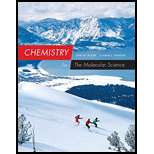
Concept explainers
A 12-oz (355-mL) Pepsi contains 38.9 mg caffeine (molar mass = 194.2 g/mol). Assume that the Pepsi, mainly water, has a density of 1.01 g/mL. For such a Pepsi, calculate: (a) its caffeine concentration in ppm; (b) its molarity of caffeine; and (c) the molality of caffeine.
(a)
Interpretation:
The caffeine concentration in
Answer to Problem 56QRT
The caffeine concentration in
Explanation of Solution
Given data as follows: Molar mass is
As known,
Conversion of water from
Conversion of
Therefore, caffeine concentration in
(b)
Interpretation:
The molarity of caffeine has to be calculated.
Concept introduction:
Molarity: Dividing moles of solute by the volume of solution in Liter.
Answer to Problem 56QRT
The caffeine concentration in
Explanation of Solution
Given data as follows: Molar mass is
Conversion of mass into mole as,
Conversion of
Molarity of solution is calculated as,
Therefore, molarity of caffeine was
(c)
Interpretation:
The molality of caffeine has to be calculated.
Concept introduction:
Molality: Dividing the moles of solute by the mass of solvent in kg.
Answer to Problem 56QRT
The molality of caffeine was
Explanation of Solution
Given data as follows: Molar mass is
Conversion of mass into mole as,
Conversion of
Conversion of water from
Molality of solution is calculated as,
Therefore, molality of caffeine was
Want to see more full solutions like this?
Chapter 13 Solutions
Chemistry: The Molecular Science, Loose-leaf Version
- What would be the freezing point of a solution formed by adding 1.0 mole of glucose (a molecular compound) to the following amounts of water? a. 250 g (0.25 kg) b. 500 g (0.500 kg) c. 1000 g (1.000 kg) d. 2000 g (2.000 kg)arrow_forward(a) If you dissolve 10.0 g (about one heaping teaspoonful) of sugar (sucrose, C12H22O11) in a cup of water (250. g), what are the mole fraction, molality, and weight percent of sugar? (b) Seawater has a sodium ion concentration of 1.08 104 ppm. If the sodium is present in the form of dissolved sodium chloride, what mass of NaCl is in each liter of seawater? Seawater is denser than pure water because of dissolved salts. Its density is 1.05 g/mLarrow_forwardSilver ion has an average concentration of 28 ppb (parts per billion) in U.S. water supplies. (a) What is the molality of the silver ion? (b) If you wanted 1.0 102 g of silver and could recover it chemically from water supplies, what volume of water in liters would you have to treat? (Assume the density of water is 1.0g/cm3.)arrow_forward
- Beaker A has 1.00 mol of chloroform, CHCl3, at 27C. Beaker B has 1.00 mol of carbon tetrachloride, CCl4, also at 27C. Equal masses of a nonvolatile, nonreactive solute are added to both beakers. In answering the questions below, the following data may be helpful. Write , =, or more information needed in the blanks provided. (a) Vapor pressure of solvent over beaker B vapor pressure of solvent over beaker A. (b) Boiling point of solution in beaker A boiling point of solution in beaker B. (c) Vapor pressure of pure CHCl3 vapor pressure of solvent over beaker A. (d) Vapor pressure lowering of solvent in beaker A vapor pressure lowering of solvent in beaker B. (e) Mole fraction of solute in beaker A mole fraction of solute in beaker B.arrow_forwardThe carbohydrate digitoxose contains 48.64% carbon and 8.16% hydrogen. The addition of 18.0 g of this compound to 100 g of water gives a solution that has a freezing point of 2.2C. a What is the molecular formula of the compound? b What is the molar mass of this compound to the nearest tenth of a gram?arrow_forwardJuice (d=1.0g/mL) from freshly harvested grapes has about 24% sucrose by mass. What is the molality of sucrose, C12H22O11, in the grape juice after 25% (by mass) of the water content has been removed? Assume a volume of 15.0 L.arrow_forward
- Calculate the freezing point of 525 g of water that contains 25.0 g of NaCl. Assume i, the vant Hoff factor, is 1.85 for NaCl.arrow_forwardBradykinin is a small peptide (9 amino acids; 1060 g/mol) that lowers blood pressure by causing blood vessels to dilate. What is the osmotic pressure of a solution of this protein at 20 C if 0.033 g of the peptide is dissolved in water to give 50.0 mL of solution?arrow_forward
 Chemistry: The Molecular ScienceChemistryISBN:9781285199047Author:John W. Moore, Conrad L. StanitskiPublisher:Cengage Learning
Chemistry: The Molecular ScienceChemistryISBN:9781285199047Author:John W. Moore, Conrad L. StanitskiPublisher:Cengage Learning Chemistry: Principles and PracticeChemistryISBN:9780534420123Author:Daniel L. Reger, Scott R. Goode, David W. Ball, Edward MercerPublisher:Cengage Learning
Chemistry: Principles and PracticeChemistryISBN:9780534420123Author:Daniel L. Reger, Scott R. Goode, David W. Ball, Edward MercerPublisher:Cengage Learning Chemistry: Principles and ReactionsChemistryISBN:9781305079373Author:William L. Masterton, Cecile N. HurleyPublisher:Cengage Learning
Chemistry: Principles and ReactionsChemistryISBN:9781305079373Author:William L. Masterton, Cecile N. HurleyPublisher:Cengage Learning Chemistry & Chemical ReactivityChemistryISBN:9781337399074Author:John C. Kotz, Paul M. Treichel, John Townsend, David TreichelPublisher:Cengage Learning
Chemistry & Chemical ReactivityChemistryISBN:9781337399074Author:John C. Kotz, Paul M. Treichel, John Townsend, David TreichelPublisher:Cengage Learning Chemistry & Chemical ReactivityChemistryISBN:9781133949640Author:John C. Kotz, Paul M. Treichel, John Townsend, David TreichelPublisher:Cengage Learning
Chemistry & Chemical ReactivityChemistryISBN:9781133949640Author:John C. Kotz, Paul M. Treichel, John Townsend, David TreichelPublisher:Cengage Learning General, Organic, and Biological ChemistryChemistryISBN:9781285853918Author:H. Stephen StokerPublisher:Cengage Learning
General, Organic, and Biological ChemistryChemistryISBN:9781285853918Author:H. Stephen StokerPublisher:Cengage Learning





